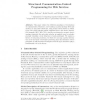Free Online Productivity Tools
i2Speak
i2Symbol
i2OCR
iTex2Img
iWeb2Print
iWeb2Shot
i2Type
iPdf2Split
iPdf2Merge
i2Bopomofo
i2Arabic
i2Style
i2Image
i2PDF
iLatex2Rtf
Sci2ools
ESOP
2007
Springer
2007
Springer
Structured Communication-Centred Programming for Web Services
This paper relates two different paradigms of descriptions of communication behaviour, one focussing on global message flows and another on end-point behaviours, using formal calculi based on session types. The global calculus, which originates from a web service description language (W3C WS-CDL), describes an interaction scenario from a vantage viewpoint; the end-point calculus, an applied typed π-calculus, precisely identifies a local behaviour of each participant. We explore a theory of end-point projection, by which we can map a global description to its end-point counterpart preserving types and dynamics. Three principles of well-structured description and the type structures play a fundamental role in the theory.
End-point Behaviours | End-point Calculus | End-point Counterpart | ESOP 2007 | Programming Languages |
Related Content
| Added | 07 Jun 2010 |
| Updated | 07 Jun 2010 |
| Type | Conference |
| Year | 2007 |
| Where | ESOP |
| Authors | Marco Carbone, Kohei Honda, Nobuko Yoshida |
Comments (0)

